Art of Indus Valley Civilisation
Art from this civilisation, including sculptures, seals, pottery, jewellery, and terracotta figures, reflects the rich cultural heritage of the era. Emerging in the second half of the third millennium BCE, these works reveal the artists' fine artistic sensibility and vivid imagination. The detailed depictions of humans and animals were highly realistic, offering a glimpse into their culture—what they wore, their facial features, and the animals they interacted with. Beyond art, the civilisation's urban planning, especially the intricate drainage system, highlights their critical thinking and attention to detail. This indicates that their art wasn’t created for mere entertainment but held deeper cultural and intellectual significance.
Stone Sculpture
Priest Bust:
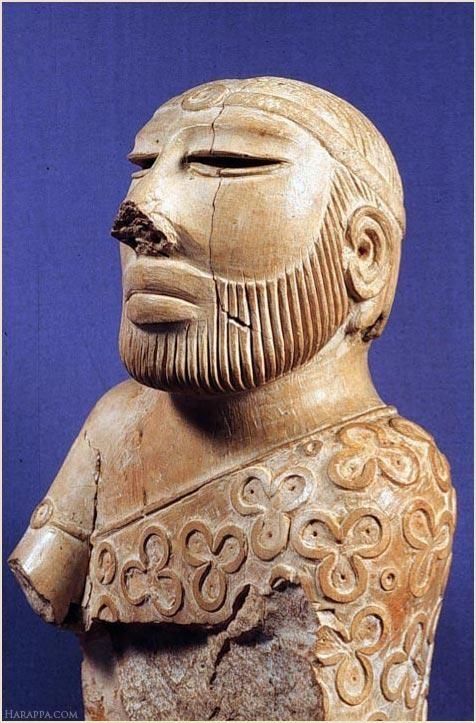
Priest Bust (image source: Pinterest)
This artifact was discovered in Mohenjo-Daro, one of the most well-known pieces from the Indus Valley Civilization of Pakistan, by Kashinath Narayan Dikshit. Made from steatite, the figure is often interpreted as a bearded priest draped in a shawl. The finely carved beard and slightly elongated, half-closed eyes suggest a meditative expression. The ears are curved, and while the arms are broken, the hair is parted in the middle, adorned with circular ornaments, possibly indicating a leader. Although the figure’s religious connection is often assumed due to the shawl and facial features its true identity remains a mystery.
Male Torso:
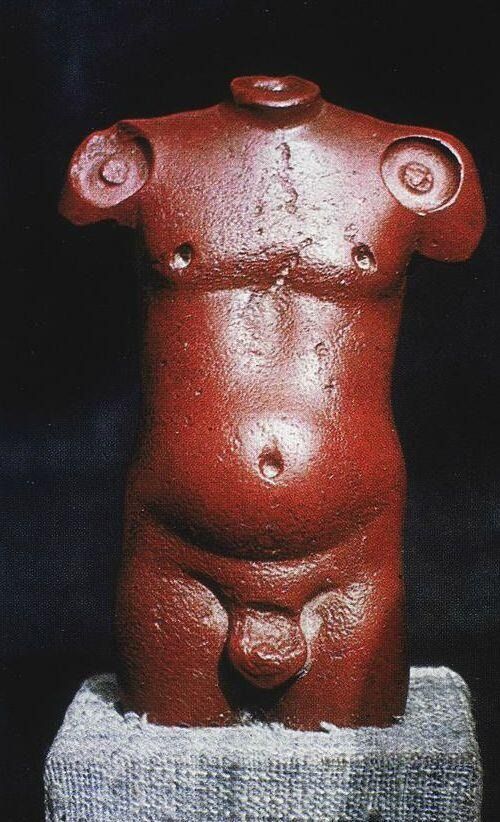
Male Torso (image source: Harappa.com)
This red sandstone statuette, discovered in Harappa, Punjab, reflects a deliberate stylistic choice in its naturalistic contours, particularly in the rounded midriff of the torso. The head, arms, and legs are missing. The nude male figure is carved with great detail, showcasing advanced sculptural techniques. Indian archaeologist Madho Sarup Vats, known for his work on the Harappan Civilization, believed this statuette dated back to the Mature Harappan Phase. The figure has been compared to the Lohanpur torso, a sculpture from the Mauryan and Kushan periods, due to its similar posture. The nudity of the figure raised questions since it was not a typical feature of Indus Valley art. Later archaeological interpretations suggest the statue's nudity may represent a negation of sexuality rather than an emphasis on it, but its true purpose remains a matter of conjecture.
Bronze Casting
Dancing Girl:
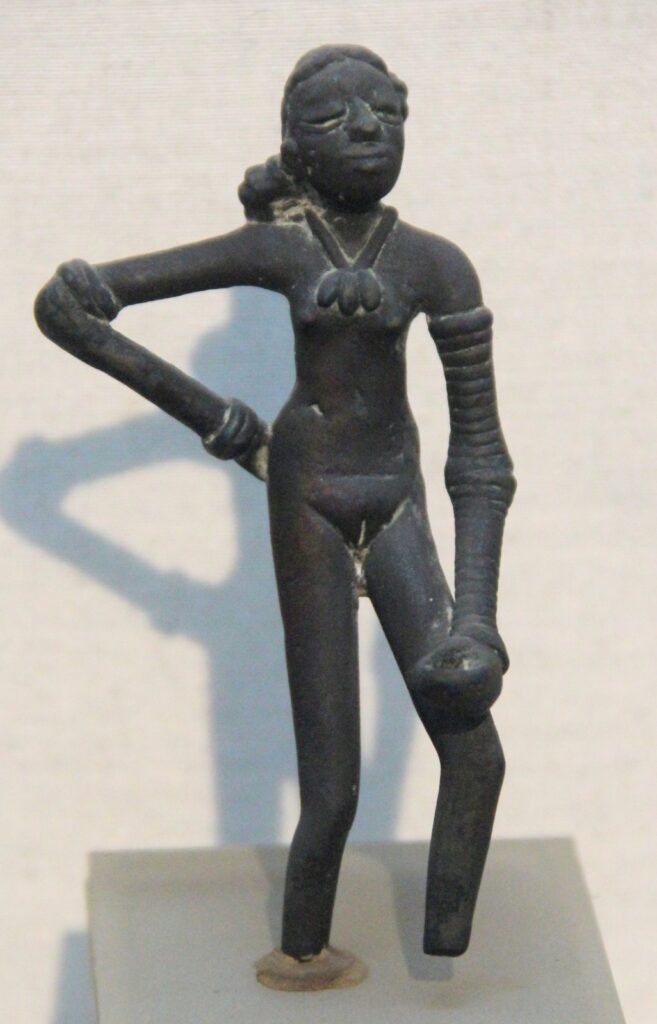
Dancing Girl (image source: Wikipedia)
Metalcraft was highly developed during the Harappan civilisation, with the bronze figurine being one of the most renowned works from the mature Harappan phase. Crafted using the lost wax casting technique, the figurine is posed in a traditional Indian dance gesture. The girl is adorned with numerous ornaments, including a necklace strung with tree leaves. Her left arm features approximately 24 bangles, while her right arm has four bangles below the elbow and at the wrist showcasing the artist's skill in capturing lifelike detail. With bunched curly hair, well-defined cheeks, full lips, and a flat nose, the figurine is thought to represent a woman of tribal origin. The artist beautifully captures the feminine grace and beauty of her uncovered breasts, waist, and thighs. This remarkable piece was discovered at the site of Mohenjo-Daro.
Women Riding Two Brahman Bulls:
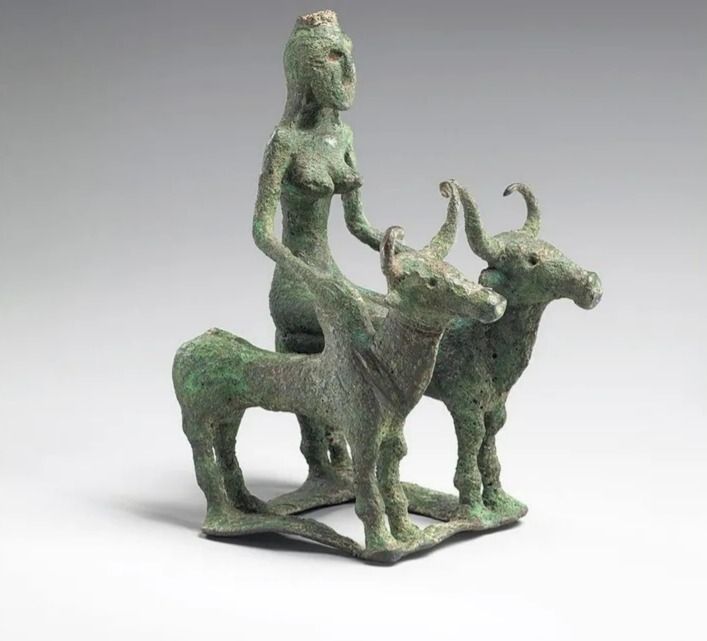
Women Riding Two Brahman Bulls (image source: mint lounge)
Many artifacts and bronze figurines depict bulls and buffaloes from that time, but this particular figure stands out as the best example of how artists provided detailed information through minimal carvings. It was discovered in Kausambi, near Allahabad, and dates back to the late Harappan phase. This sculpture is one of the oldest surviving examples of bronze work. Some scholars suggest that it represents the goddess Durga or another deity, while others believe it reflects the essence of their lifestyle, where women were depicted riding bulls and taking on significant roles.
Terracotta Art
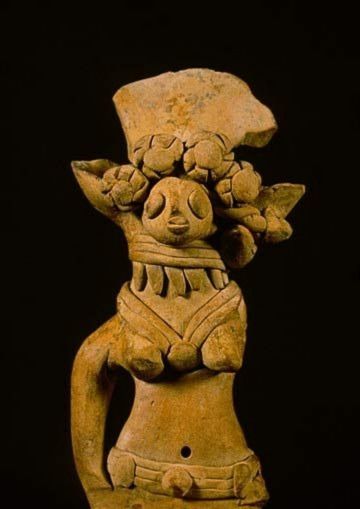
Mother of Goddess (image source: Pinterest)
The form of terracotta in this civilisation is cruder compared to stone and bronze. Particularly in sites like Gujarat and Kalibangan, these figurines are more realistic. The terracotta pieces include masks depicting deities, toy carts with wheels, whistles, rattles, birds, animals, gamesmen, and discs. Among the most significant artefacts is the figurine of the Mother Goddess, discovered at multiple excavation sites. This suggests that the worship of the Mother Goddess was a widespread practice in the Indus Valley, as well as in other ancient cultures like the Mesopotamian civilisation. Archaeologists believe these terracotta figures served as votive idols, reflecting a tradition of goddess worship that continues today with reverence for Gramdevi, Shakti Devi, and Bhudevi.
Seals of the Civilisation
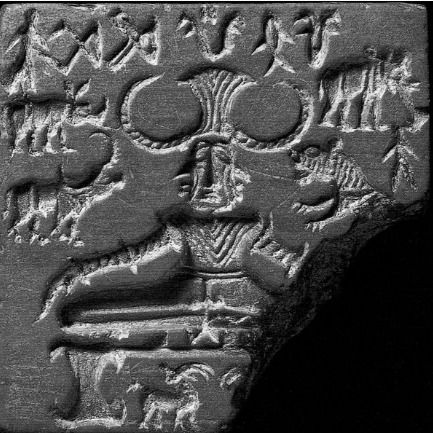
Pashupati seal (image source: Map Academy)
Seals from the Indus Valley Civilization were intricately carved from materials such as steatite, copper, faience, terracotta, chert, ivory, and gold. To enhance their durability, these seals were often subjected to burning. Featuring detailed depictions of animals like horses, bulls, tigers, elephants, bison, goats, and buffaloes, each seal was engraved with a pictographic script that remains undeciphered. These seals played a crucial role in commercial activities, including sealing jars, creating clay tags for sacks carrying goods, and facilitating trade. A significant number of these seals have been discovered in the port city of Lothal.
Among the notable finds is the Pashupati seal from Mohenjo-Daro, which is named after the deity Shiva, known as the "lord of all animals." The seal depicts Shiva in a meditative pose resembling the yogic padmasana, surrounded by representations of a deer, tiger, buffalo, and rhinoceros. The inscription along the top edge of the seal is still undeciphered. While some scholars suggest the figure might represent other deities such as Mahishasura, Agni, Anila, or Varuna.
Pottery

Pottery of Indus Valley Civilisation (image source: VMIS)
A vast collection of pottery was excavated from the sites, mostly consisting of fine, wheel-made wares, with very few hand-made pieces. The motifs and shapes vary by style, with plain pottery being more common than painted. Typically, red clay was used, including knobbed ware. The black-painted pottery features a fine red slip coating, adorned with geometric and animal designs. Polychrome pottery is rare, usually comprising small vases decorated with geometric patterns in red, black, and green, with white or yellow being seldom used. Incised decorations were generally confined to the bases of pans, always inside, and the dishes of offering stands. Perforated pottery, featuring a large hole at the bottom and smaller holes throughout the walls, was likely used for straining beverages. Miniature vessels, often less than half an inch in height, are remarkably crafted, evoking admiration for their precision.
Handmade Jewellery and Ornament
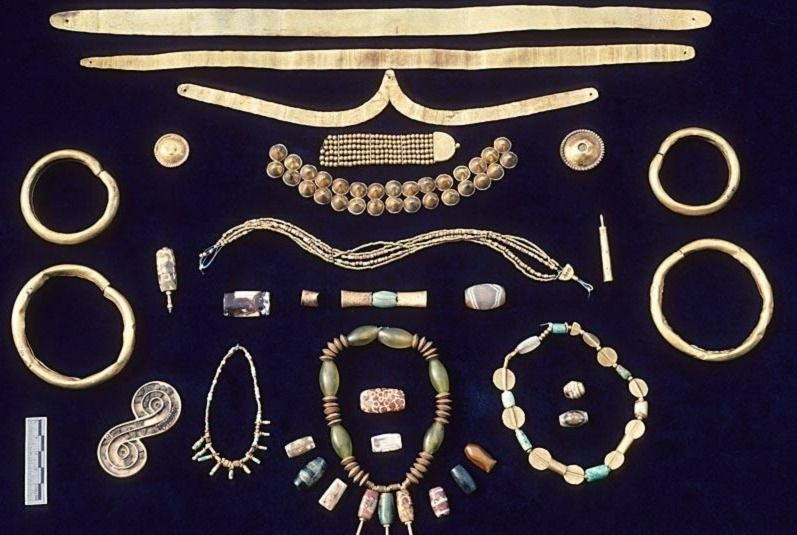
Ornaments of Indus Valley Civilisation (image source: Harappa.com)
Skilled artisans crafted intricate handmade jewellery using materials like precious metals, gemstones, bone, and baked clay. Archaeologists have uncovered beautifully crafted pieces, including gold and semi-precious stone necklaces, bracelets, beaded earrings, and faience pendants, buttons, and beads made from steatite. The bead-making industry was highly advanced, with factories found at sites like Chanhudaro and Lothal. Beads were crafted from a variety of materials, including carnelian, amethyst, jasper, crystal, quartz, turquoise, lapis lazuli, copper, bronze, gold, shell, faience, and terracotta. These beads came in many shapes, such as disc-shaped, cylindrical, spherical, barrel-shaped, and segmented. A notable discovery at a cemetery in Farmana, Haryana, revealed that people were often buried with their jewellery, highlighting the cultural significance of ornaments in ancient societies.
In Conclusion,
The sculptures, terracotta art, ornaments, pottery, and seals from the Indus Valley Civilisation are carefully preserved in museums across India and Pakistan. Archaeologists divided these artefacts according to their discovery sites. National Museum of India in Delhi, which boasts the famous bronze statue of the Dancing Girl. In Gujarat, the Lothal Archaeological Museum displays artefacts unearthed from the Lothal site, while Mumbai holds a significant collection as well. Pakistan’s Harappa Museum, National Museum in Karachi, and Lahore Museum also preserve many of these invaluable pieces, found within their respective regions of the civilisation. These artefacts offer glimpses into the lives, culture, and artistry of the civilisation, though much remains unknown due to the undeciphered script and the fragmented nature of many discoveries. By safeguarding these treasures, we not only honour the past but also provide future generations with the opportunity to delve deeper into the mysteries of one of the world's earliest civilisations.
To learn more about Indian art and artists, download the Rooftop app from the App Store or Google Play to stay updated on our upcoming art events and workshops. Stay tuned to rooftop blogs and follow us on @rooftop_app.
By Shrushti Patel